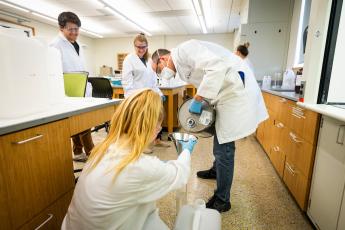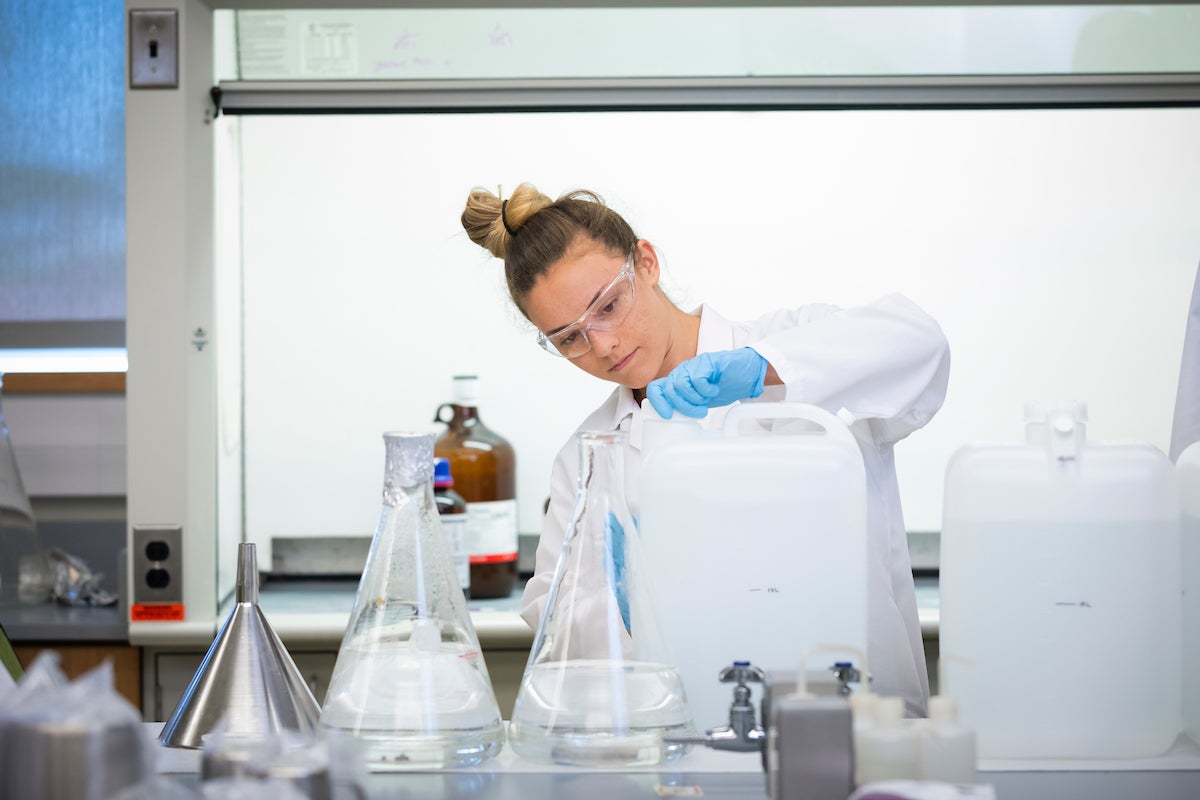Chemistry and Biochemistry Faculty, Staff and Students Produce Hand Sanitizer for Campus Use

When hand sanitizer started flying off local shelves about two months ago, Cal Poly chemistry professor Scott Eagon decided to turn a difficult situation into a hands-on learning opportunity for several students, and help the community in the process.
“There have been times recently when it’s been difficult to obtain sanitizer, and we wanted to help the local community as much as possible,” Eagon said. “It took me some time to collect everything and to find a place to store and distribute it.”
 Eagon, who runs a medical chemistry lab, emailed his research students to see if anyone was still in San Luis Obispo and wanted to help. “A lot of them want to help in any way to fight the pandemic,” he said.
Eagon, who runs a medical chemistry lab, emailed his research students to see if anyone was still in San Luis Obispo and wanted to help. “A lot of them want to help in any way to fight the pandemic,” he said.
Six volunteered: biochemistry majors Spenser Platt, Eric Schwegman and Julia Gibbs; biomedical engineering major Maetja (Metty) Verbarendse; biological sciences major Jessica Travis; and biological sciences and psychology major Trevan Klug.
“I was really excited because it meant I could do something to help against the coronavirus and I could get back in the lab,” Schwegman said.
Biochemistry instructional support technician Andrea Labschuer prepared the sanitized water, and chemistry instructional support technician Shelley Zoff helped procure critical supplies, including alcohol, glycerol and peroxide.
On May 15, the students gathered in the general chemistry laboratories in the Baker Center for Science and Mathematics. Wearing protective equipment, they split into two groups and mixed two different types of sanitizer: ethyl-alcohol based and isopropyl-alcohol based, in proper ratios designated by the World Health Organization.
Both are simple mixtures of alcohol, sterilized water and glycerol. A small amount of peroxide was added to destroy any microbes that may have gotten in the batch. Then, the mixtures were allowed to “cure,” Eagon said, during which time the remaining peroxide breaks down into water.
The glycerol acts like a moisturizer and keeps your hands from drying out too much, he said. “We avoid adding any fragrances, dyes, foaming agents, etc. to minimize the chance of any allergic reaction.”
They produced six 16-liter batches of sanitizer, or around 25 gallons.
“A lot of our projects take months if not years to come to fruition but making hand sanitizer was a way to immediately able to help our community and make a difference, especially with the uncertainty of this pandemic,” said Verbarendse, a third-year biomedical engineering student.
“It was great to be back on campus, see my research team and help the community,” she added. “Being able to come onto campus even for a short time made me excited to return to campus and work in lab when this is all over.”
Cal Poly’s Facilities Services division will store the finished product in its warehouse and use it to supplement current campus supplies by transferring the product to smaller, user-friendly spray bottles. These supplies are being used by current on-campus essential personnel including University Housing, Cal Poly police, and Facilities Management and Development.
“There is a very good chance we will need this supply before we are able to replenish stock via normal supply chain methods,” said Jude Fledderman, executive director of Facilities Operations.




